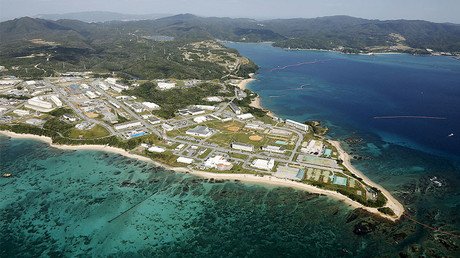Construction for US base relocation in Okinawa continues amid protests (VIDEOS)
Construction for a new US military base on the Japanese island of Okinawa has taken another step forward, despite ongoing protests against the heavy American military presence and crimes committed by servicemen.
Cranes could be seen lifting nets containing crushed rock and dropping them along the shore north of nearby Camp Schwab on Tuesday, according to videos posted by Japanese media.
The rocks will likely serve as the foundation of a seawall built along the outer perimeter of the planned runway site, according to The Asahi Shimbun.
The move represents a step forward in the controversial relocation of the US Marine Corps Futenma Air Station from Ginowan to the less-populated area of Henoko, in Nago.
Full-fledged landfill work inside the sea walls is set to take place in the first half of next year.
It comes despite protests against the relocation from Okinawa Governor Takeshi Onaga and disgruntled residents, all of whom want Okinawa freed of the base and the heavy US military presence on the island.
Katsuhiro Yoshida, a senior Okinawa prefectural official tasked with dealing with issues concerning US bases in the prefecture, said the move “ignored the local will” and is “authoritarian,” adding that local citizens simply cannot accept it.
Onaga is considering blocking the construction through legal action, claiming the central government is required to obtain his permission for the construction work, and that the last such permit expired at the end of March.
The governor has also threatened to retract approval for the landfill work, according to Kyodo news agency.
Onaga’s previous efforts against the base relocation were thwarted, with Japan’s Supreme Court ruling in December that it is illegal for the governor to revoke the approval for land reclamation, which was granted by his predecessor, Hirokazu Nakaima.
Despite that ruling, Onaga can still move for a revocation based on claims that the situation has changed since his predecessor granted the approval.
Onaga is not alone in consistently voicing disapproval with the base relocation. Mass demonstrations against US bases on the island have become common.
Around 100 protesters demonstrated in front of the gates of neighboring US Marine Corps base Camp Schwab on Tuesday, holding signs which read “Stop illegal construction work” and “Block the new base!”
One protester cited the infamous 1995 rape of a local girl by US servicemen, saying that the crime would not have occurred if there were no bases on the island.
READ MORE: US base buzz: Japan to pay Okinawa residents record $267mn in damages over jet noise
In addition to the protest at Camp Schwab, about 10 demonstrators in canoes approached the construction site from the sea.
Many Okinawa residents have long been opposed to the high number of US military bases on the island, which hosts 74 percent of Japan’s total US military presence, despite taking up less than one percent of Japanese territory.
Crimes committed by servicemen – including the 2016 rape of a Japanese tourist – are on the list of the residents’ complaints, along with noise, accidents, and environmental concerns. Onaga himself has claimed the base relocation will destroy the environment of the surrounding bay.
The relocation of the air station began in October 2015, but was suspended due to resistance from the Okinawa authorities and local population.













